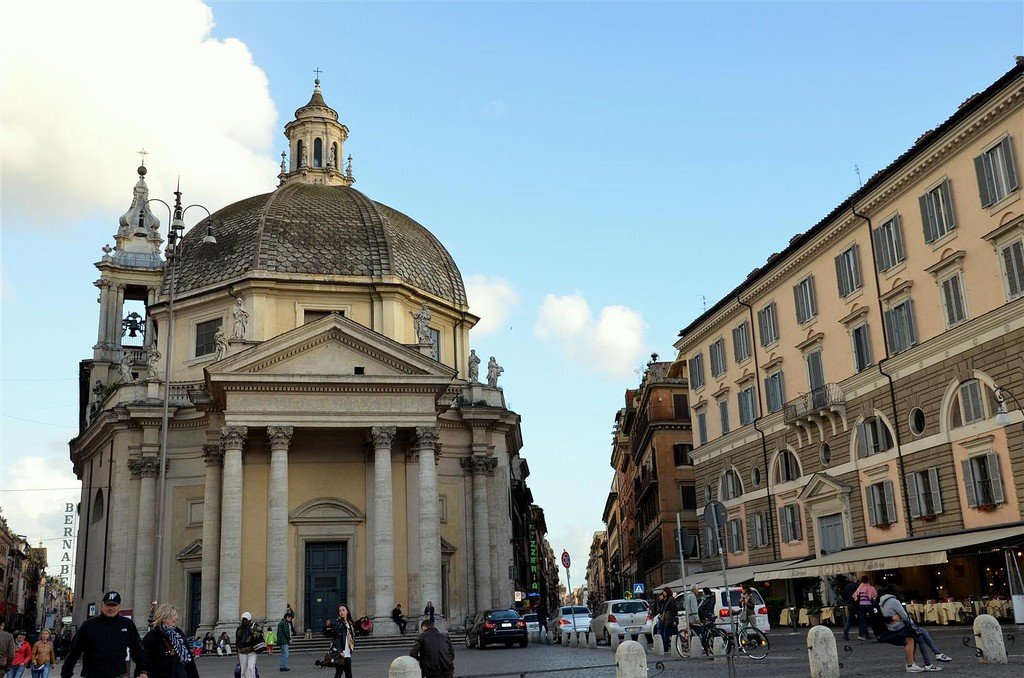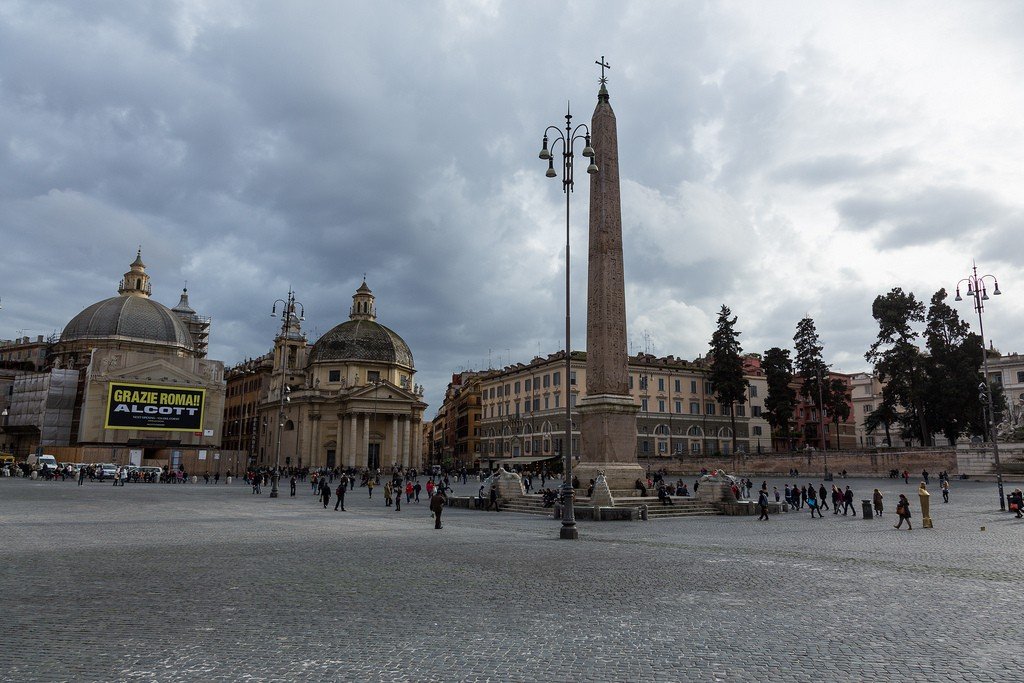Piazza del Popolo
Piazza del Popolo is a Roman square that has become one of the most famous in the world. The elegant architectural design by Giuseppe Valadier has survived for centuries and is consistently admired by tourists. Piazza del Popolo has an oval shape, with the obelisk of Flaminio in its center. From the square start and lead in a southerly direction lively streets Ripetta, Corso and Babuino. Between these thoroughfares, adjacent to the Popolo, are the ancient paired churches of Santa Maria dei Miracoli and Santa Maria in Montesanto.










Video: Piazza del Popolo
ContentsHighlights
Piazza del Popolo has impressive dimensions: 100 × 165 meters. This gives it the right to be considered the largest square in Rome. It belongs to the Old Town, and many sightseeing tours of the Italian capital start from here. Piazza del Popolo is entirely pedestrianized, and any vehicular traffic is prohibited.
.Not only travelers, but also locals like to stroll here. Local magicians, stage performers and wandering musicians add a special flavor. On holidays, concerts are held here. The picturesque square has inspired artists countless times. Writers such as Stendhal, Dickens, Goethe and Gogol have also made their mark here.
.
Piazza del Popolo is connected to Piazza Venezia by Via del Corso. Getting to Via del Corso is a cherished dream of any shopaholic. Tourists call it the main street in the city because of the abundance of stores, restaurants, hotels, and magnificent palazzos. From the west of Corso stretches Ripetta Street, leading from Piazza del Popolo to the Mausoleum of Augustus. The third ray is Via Babuino. It is located to the east of the Corso. Travelers leaving Piazza del Popolo on Via del Babuino end up on Piazza España. The Spanish Steps, a grand Baroque structure of 135 steps, is a must-see here.
.History of Piazza del Popolo
Until the mid-nineteenth century, the time of the spread of railroads throughout Italy, Piazza del Popolo was of great strategic importance. It was served by tracks from the north, including the ancient Flaminia Road, which was used by most people.
To reach the square, one had to pass through the Porta del Popolo gate. In antiquity, the arch was an extension of the Aurelian Wall. The gate was originally called Flaminia Gate, after the road.
.
Arriving visitors and pilgrims formed their first impression of the Eternal City largely thanks to the legendary square. If they could share their impressions, they would probably say that Piazza del Popolo looked more like a suburb than the hallmark of the papal capital. In its center stood troughs of water; horses drank from them. It was also, until 1826, a place to witness an execution.
Piazza del Popolo became an architectural ornament in 1573. Italian sculptor and architect Giacomo della Porta, by order of Pope Gregory XIII, installed a fountain in the square.
.
In the 16th century, Rome’s population was growing rapidly, and the city was actually being built up only around the ruins of ancient buildings and temples. The entire infrastructure was falling into disrepair and could not withstand the growing strain: aqueducts and sewers were breaking down. In this regard, Pope Sixtus V began to urbanize Rome. As a first step, he commissioned the architect and engineer Domenico Fontana to develop an efficient road scheme. New streets were to link the most important places in Rome, thus avoiding chaos. Key points in the city were to be marked with obelisks.
Grandiose plans were not destined to come true for a prosaic reason – due to lack of funding. Fontana was only able to install obelisks in significant places, but these monuments became clues for future generations of Roman city planners. For example, the Egyptian Obelisk, also known as the Obelisk of Flaminio, appeared on the Piazza del Popolo in 1589. According to the architect’s plan, three central streets should lead to it. This layout is called radial trident or “goosefoot”. The obelisk had to be placed in the place where the fountain already stood, so the latter was moved to the south.
.
The last major reconstruction of the Piazza del Popolo took place between 1811 and 1822, under the direction of Giuseppe Valadier. The square we see today is the masterpiece of this talented architect and urban planner, but also a jeweler, restorer and archaeologist. Valadier faced a difficult task – to create a single impressive ensemble from the existing heterogeneous architecture, some of which could not be demolished due to its historical and cultural value.
.
Valadier connected Piazza del Popolo to Pincio Hill with the Napoleonic Staircase. All the walls and buildings that did not play a significant role were demolished. A public park appeared, through which stretched a road suitable for carriage transport. The hill was artificially enlarged and a terrace was created on it. On the perimeter of the square, in the empty spaces built houses. On the Piazza del Popolo itself, Valadier regulated traffic by building two semicircles. Thus, the square became oval rather than round, as had been the custom of earlier construction. Columns, sculptures, retaining walls, and pine trees were also added. All this gave the square a bright baroque look. Giuseppe Valadier is rightly called the author of the Piazza del Popolo.
. Between 1822 and 1823. Giovanni Ceccarini added the most beautiful fountains to the square. The fountain of Neptune is set in the western part, on the side of the Tiber; the fountain of the goddess Roma is on the east, on the side of the Borghese Gardens. The central fountain with lion figures is located next to the obelisk..Origin of the name
Piazza del Popolo literally translates as “people’s square”. There are two interpretations for this name.
According to the first version, the name of the square was given by poplar trees. The trees grew near the mausoleum of the ancient Roman Emperor Nero, formerly located near the square. In Latin, the words “poplar” and “people” are the same – populus. Legend has it that Nero’s ghost still comes here at night.
.
Another theory says that the square became “populus” because the chapel of Santa Maria del Popolo located here was also called so. Pope Paschal II built it with money collected from the people.
>
What to see
Once in Piazza del Popolo, tourists immediately notice the 24-meter tall obelisk of Flaminio. The stone stele is the architectural dominant and rises right in the center. The obelisk was brought to Rome from Heliopolis as a trophy, on the orders of Octavian Augustus, in 10 B.C. The age of the stela is over 3000 years old, it was built under Ramses II and Maneptarchus, in the XIII century B.C. The Egyptian obelisk is decorated with bas-reliefs, which reflect the main milestones of the reign of the pharaohs.
.Originally, the obelisk of Flaminio stood in front of the Grand Circus. After the collapse of the Empire, it suffered an unenviable fate – the column was simply buried. Domenico Fontana had to restore the obelisk before it could be erected in the square.
.
In the southern part of Piazza del Popolo two twin churches stand out – Santa Maria dei Miracoli and Santa Maria in Montesanto. Their construction took place between 1662 and 1679. The project was entrusted to Carlo Rainaldi, one of the greatest Italian architects, who contributed the most to the Baroque appearance of Rome. Rainaldi’s project was not realized immediately due to financial constraints, so later Carlo Fontana and Giovanni Lorenzo Bernini were in charge of the finalization. The paired churches look monumental, have rounded domes covered with slate tiles. Interesting fact: the plot of land between Via Ripetta and Via Corso is narrower than that between Via Corso and Via Babuino, but the churches were meant to look the same. Rainaldi planned to build both basilicas as 8-dome basilicas, but to give Santa Maria in Montesanto an oval shape, moving it slightly away from the square. Santa Maria dei Miracoli would have remained round, but from afar, when looking at the churches from the Porta del Popolo gate, the structures would have appeared identical. Fontana and Bernini, in turn, made the dome for Santa Maria in Montesanto 12-domed. In doing so, the side facing the square is wider than the others, so as not to destroy the visual identity..
To the north of Piazza del Popolo, near the city gate, can be seen an ancient basilica built in the shape of a Latin cross. The history of the church of Santa Maria del Popolo goes back to the eleventh century. According to legends, earlier on the site of Santa Maria del Popolo was the tomb of Nero. In 1099, Pope Paschal II erected a chapel in this place with people’s money. On its basis in 1472-1477 the church was completed and acquired the familiar appearance.
.
How to get there
Address: Piazza del Popolo, 48121 Rome.
.Piazza del Popolo is reached by most ground transportation, as it is one of the city’s main attractions. Travelers also reach Piazza del Popolo by metro. One can disembark at the Piazza España station and walk north along Via Babuino for 10 minutes.
.